Bird stomach contents analysis - final report: Goosander and Cormorant diet on four Scottish rivers 2019 to 2020
This study analysed the stomach contents of goosanders and cormorants collected from the Rivers Tweed, Dee, Nith and Spey during 2019 and 2020 in order to to assess whether there was evidence of substantial changes in the diets of these species of fish-eating birds since the 1990s.
3. Samples
Samples: numbers of birds
In many instances, smaller numbers of birds were collected than the sampling protocol requested. The numbers collected are detailed below for (a) the smolt run period (Table 1), and (b) the following autumn-winter period (Table 2).
| River | Species | Total | Empty | With food | Months |
|---|---|---|---|---|---|
| (1a) R. Dee | Goosander | 20 | 1 | 19 | Mar/May |
| (2a) R. Nith | Goosander | 15 | 2 | 13 | Apr/May |
| (3a) R. Tweed | Goosander | 14 | 2 | 12 | Apr/May |
| (4a) R. Spey | Goosander | 15 | 2 | 13 | Mar/Apr |
| (5a) R. Dee | Cormorant | 0 | 0 | 0 | - |
| (6a) R. Nith | Cormorant | 6 | 3 | 3 | Mar/Apr |
| (7a) R. Tweed | Cormorant | 9 | 3 | 6 | Apr/May |
| (8a) R. Spey | Cormorant | 1 | 0 | 1 | April |
| River | Species | Total | Empty | With food | Months |
|---|---|---|---|---|---|
| (1b) R. Dee | Goosander | 2 | 0 | 2 | Nov |
| (2b) R. Nith | Goosander | 10 | 0 | 10 | Oct-Feb |
| (3b) R. Tweed | Goosander | 24 | 0 | 24 | Sep-Nov |
| (4b) R. Spey | Goosander | 8 | 1 | 7 | Sep-Dec |
| (5b) R. Dee | Cormorant | 4 | 1 | 3 | Dec-Jan |
| (6b) R. Nith | Cormorant | 12 | 0 | 12 | Nov-Feb |
| (7b) R. Tweed | Cormorant | 27 | 3 | 24 | Sep-Nov |
| (8b) R. Spey | Cormorant | 13 | 5 | 8 | Dec-Feb |
Samples: chronology
(1) Goosanders
During spring 2019, most Goosanders were sampled in April, with some in May, and a few in March. Later in the year, most Goosanders were sampled in the autumn (Sep-Nov) and relatively few in the winter (Dec-Feb).
The monthly numbers of Goosanders collected throughout the study period is shown in Figure 2.
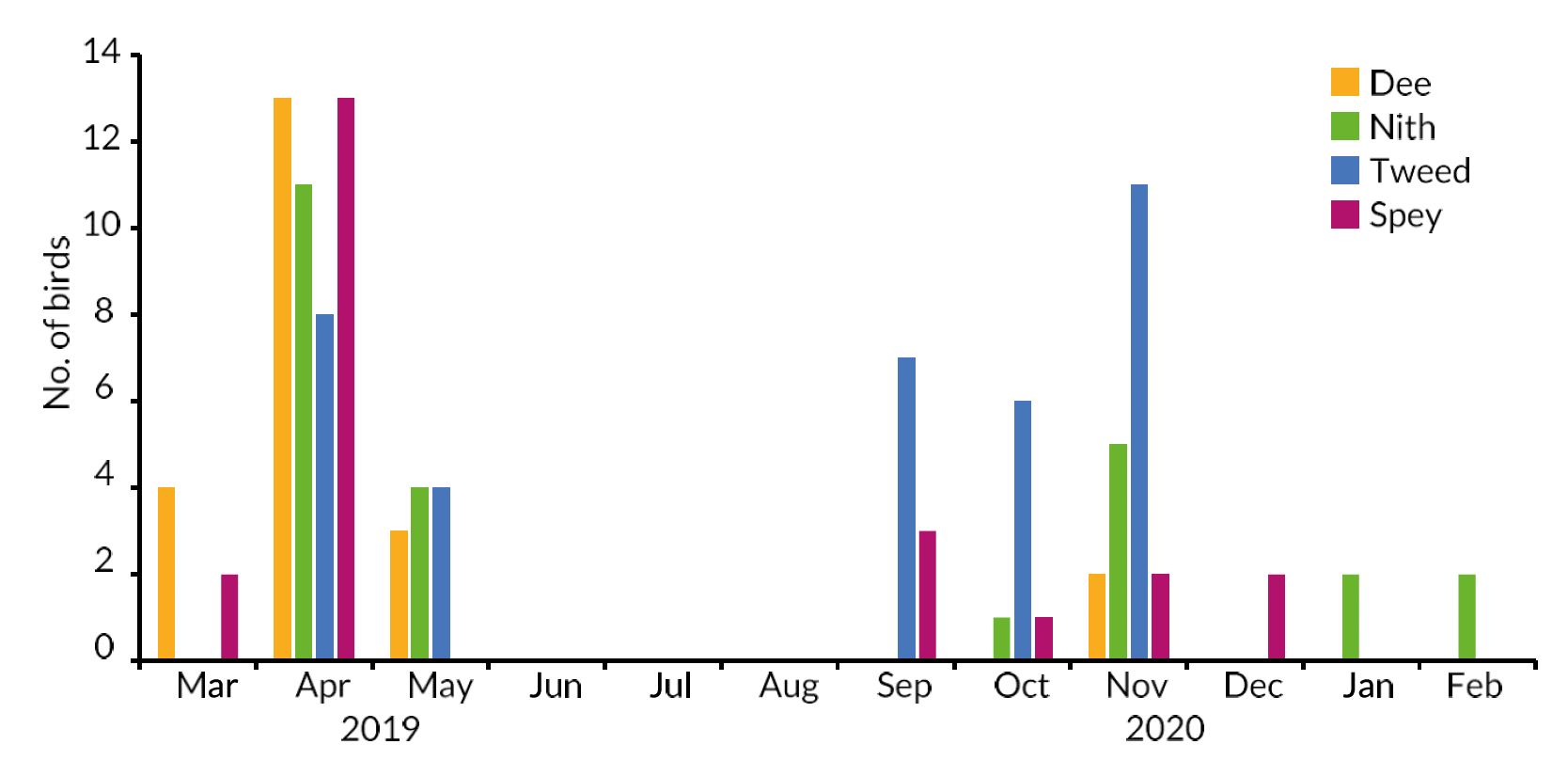
(2) Cormorants
During spring 2019, only a small number of Cormorants were sampled in April and in May. Later in the year, all R. Tweed Cormorants were sampled in the autumn (Sep-Nov), and most birds from other rivers were collected in the winter (Dec-Feb). The monthly numbers of Cormorants collected throughout the study period is shown in Figure 3.
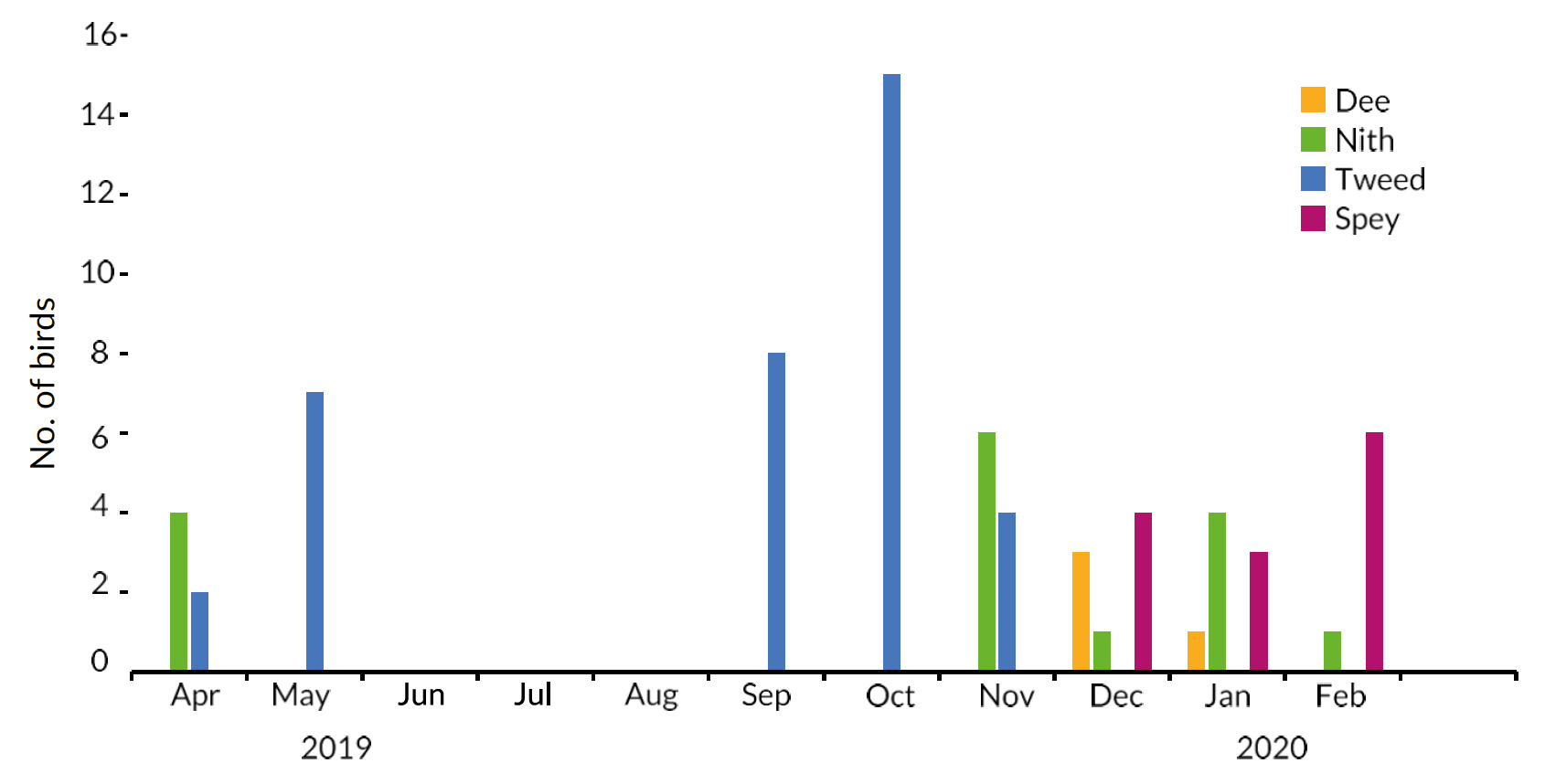
Full details of the chronology of samples received are given in Appendix 3.
Samples: location
In the lists below, the sampling locations (by fishing beat) are given in bold and ordered downstream to upstream, with any other available information in parenthesis. Fishing beats are also shown in maps for each study river (Figures 4 to 7).
(a) smolt run period
During spring 2019, Goosanders from the R. Dee were collected from Lower Crathes, Woodend, Commonty (Cattie Burn), Sluie, Borrowston (Sands Pool), Dess, and Crathie (Polmonier). Goosanders from the R. Nith came from Cowhill, Blackwood (including Auldgirth), Barjarg (including Cleughfoot), Buccleuch, and Upper Nithsdale (Dalpeddar). Goosanders from the R. Tweed were sampled from the Lees, Lower Floors, Markestoun, Rutherford, and Bemersyde. Those from the R. Spey were sampled at Easter Echlies (including Orn's Beat and Inverfiddich), Pitchroy, Ballindalloch Tulchan (B and D), and Castle Grant.
No Cormorants were sampled on the R. Dee in spring 2019. Birds from the R. Nith were taken from Cowhill, Boatford (Newhole), Buccleuch (Lower) (Doctor's Pool), and Buccleuch (Mid) (Whitehill). Cormorants from the R. Tweed came from the Lees, Rutherford, and Bemersyde, and the single Cormorant available from the Spey came from Kinchurdy.
(b) autumn-winter period
During the autumn winter 2019/20, Goosanders from the R. Dee were collected from Lower Crathes (including Greenbanks). Goosanders from the R.Nith came from Dalswinton, Blackwood, Boatford (including Kirkbog), Buccleuch, and Buccleuch (Mid) (including Whitehill). Goosanders from the R. Tweed were sampled from the Lees, Hendersyde, Lower Floors, Markestoun (Upper and Lower), Middle Mertoun, and Bemersyde. Those from the R. Spey were sampled at Low Water (Groynes), Arndilly, Easter Elchies, Pitchroy, and a single bird had no location provided.
Cormorants from the R. Dee were collected from only Lower Crathes. Cormorants from the R. Nith came from Cowhill, Blackwood, Boatford (Kirkbog), and Buccleuch (Mid) (Whitehill). Cormorants from the R. Tweed were sampled from Ladykirk, the Lees, Hendersyde, Lower Floors, Rutherford, Middle Mertoun, and Bemersyde. Those from the R. Spey were sampled at Brae Water (including Intake, Beat 5, Flats Pool), Delfur, Arndilly, Easter Elchies (including Inverfiddich), Knockando Tulchan (D), and Kinchurdy.
Full details of the locations of all samples received are given in Appendix 3.
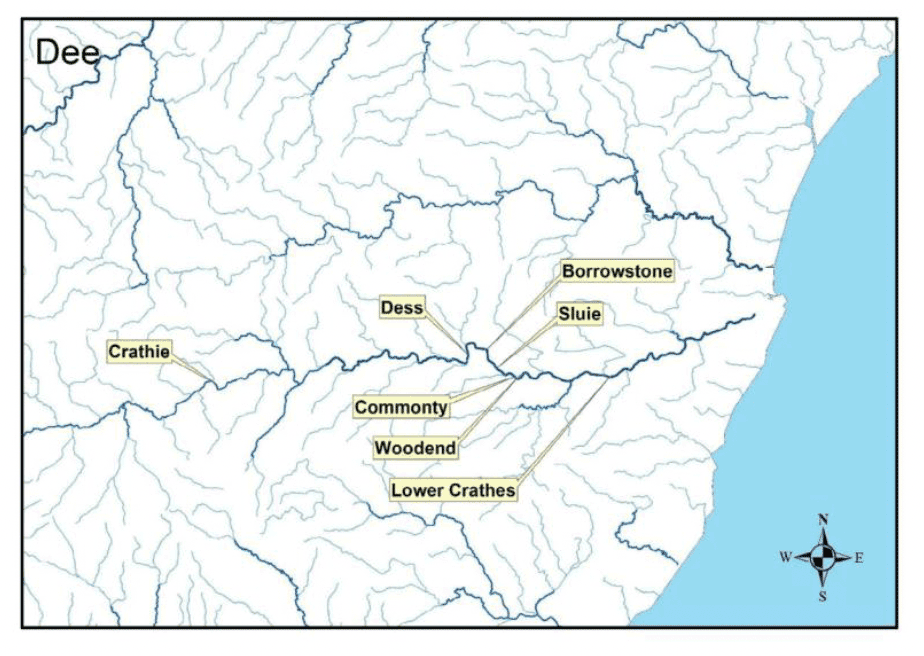
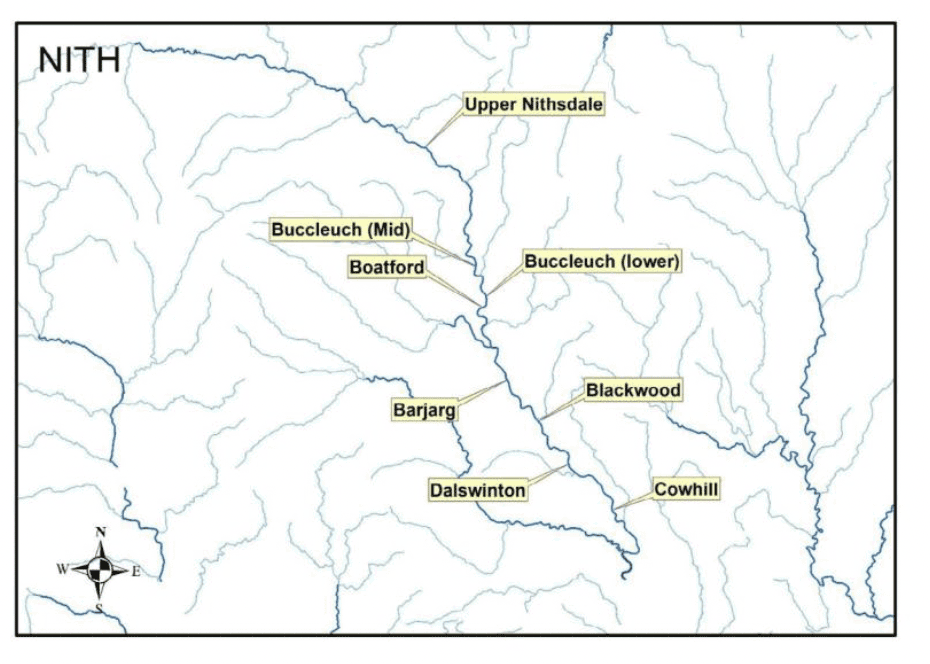
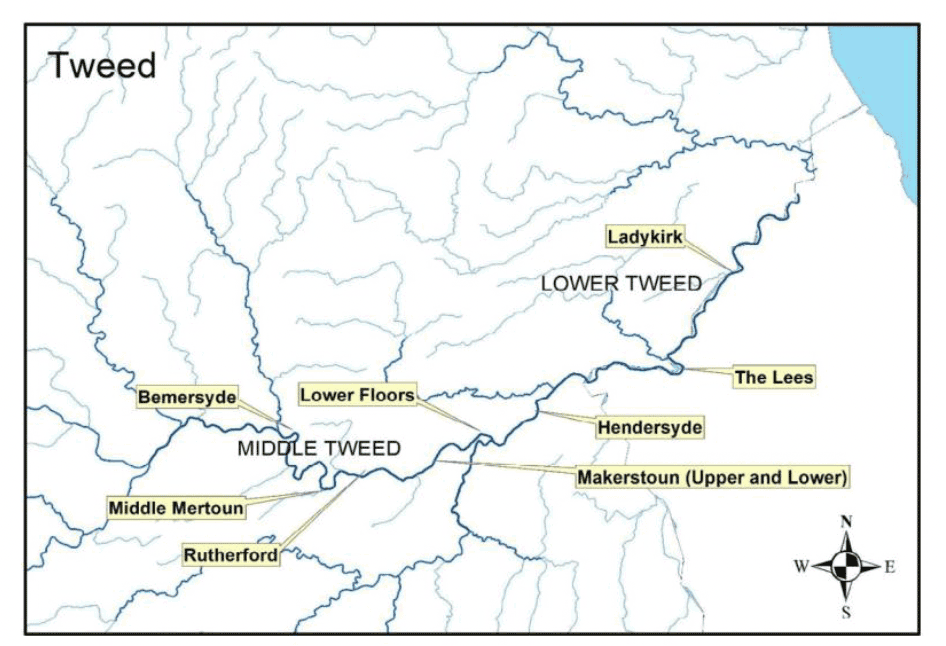
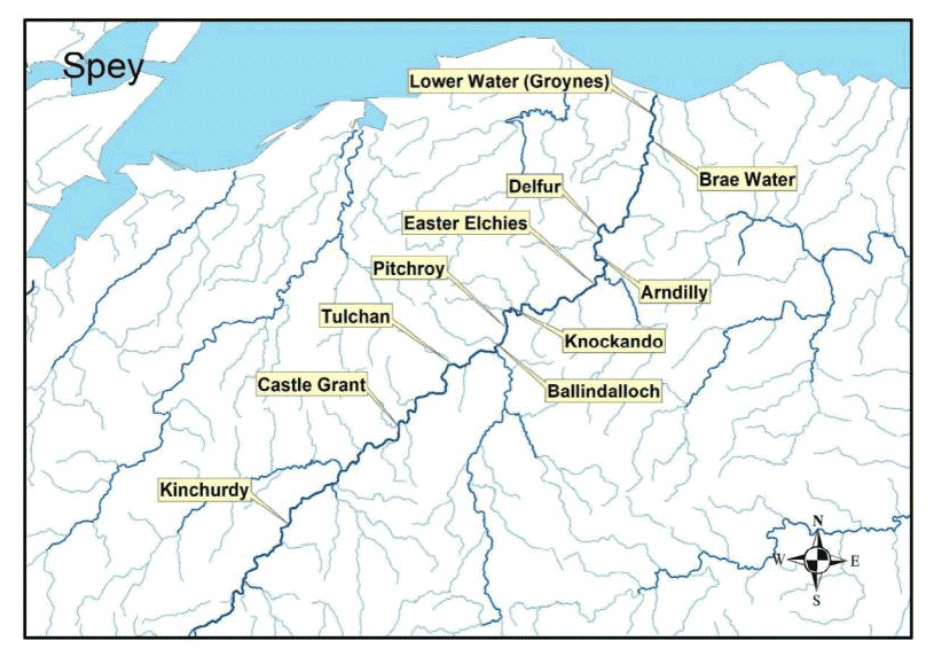
Comparable historical datasets (Marquiss et al. 1998)
(a) smolt run period
For the R. Tweed, knowledge of the sampling locations allowed comparison with specific stretches mentioned in Appendices 5.1 and 5.3 of Marquiss et al. (1998). All Goosanders sampled in spring 2019 were within the 'Melrose-Coldstream' section used by Marquiss et al. (1998). Comparable 1990s samples from this section of river were available for April 1991 (Appendix 5.1, table 22f), April 1992 (5.1, table 22p), April/May 1994 (5.1, table 22y), and April 1995 (5.1, table 22bb – which DNC found to be wrongly dated as 'March' in the original report). This same river section was also appropriate for the R. Tweed Cormorants and the relevant comparable samples were March/May 1994 (no locations given, 5.3, table 22i), and March/April 1995 (no locations given, 5.3, table 22j).
Previous analysis for the other rivers did not differentiate between specific river sections and so comparisons could only be made with samples collected in similar months. For R. Dee Goosanders, comparable samples were in March/April 1995 (Appendix 5.1, table 9f), and "spring" 1996 (5.1, table 9i). For R. Nith Goosanders, comparable data were March/April 1993 (5.1, table 17d), April 1994 (5.1, table 17e), and March/April 1995 (5.1, table 17f). For R. Nith Cormorants, only very broad comparisons could be made (because samples of birds were small) with February/April 1991 and March/April 1992 (Appendix 5.3, 14a and 14b, respectively). For R. Spey Goosanders, comparable samples were April 1993 (Appendix 5.1, table 20a), March/April 1994 (5.1, table 20b), and April 1996 (5.1, table 20c), although only the latter sample was large enough to provide an adequate estimate of diet. Little meaningful comparison could be made for the single R. Spey Cormorant from 2019, samples from "spring" 1993 and March/April 1994 (Appendix 5.3, 19a and 19b, respectively) were relevant but samples of birds were again very small.
(b) autumn-winter period
Unlike the smolt run samples detailed above, only two possible comparisons could be made between the current autumn-winter 2019/20 samples and those from a similar period in earlier years (i.e. Tweed Goosanders, Tables 22[k] and 22[v] of Appendix 5.1 in Marquiss et al. 1998). This was because either no samples were available in most cases, or sample sizes were very small (i.e. three samples each with only 3-4 stomachs containing food).
Contact
There is a problem
Thanks for your feedback